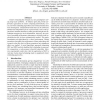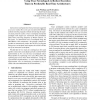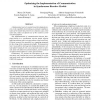91
Voted
RTAS
2007
IEEE
15 years 7 months ago
2007
IEEE
Using preemption threshold scheduling (PTS) in a multi-threaded real-time embedded system reduces system preemptions and hence reduces run-time overhead while still ensuring real-...
117
Voted
RTAS
2007
IEEE
15 years 7 months ago
2007
IEEE
It is challenging to manage the performance of real-time databases (RTDBs) that are often used in data-intensive real-time applications such as agile manufacturing and target trac...
90
Voted
RTAS
2007
IEEE
15 years 7 months ago
2007
IEEE
Stochastic analysis techniques for real-time systems model the execution time of tasks as random variables. These techniques constitute a very powerful tool to study the behaviour...
75
Voted
RTAS
2007
IEEE
15 years 7 months ago
2007
IEEE
The availability of programmable hardware devices with high density of logic elements and the possibility of implementing CPUs (called softcores) using a fraction of the FPGA area...
134
Voted
RTAS
2007
IEEE
15 years 7 months ago
2007
IEEE
Cluster computing has emerged as a new paradigm for solving large-scale problems. To enhance QoS and provide performance guarantees in cluster computing environments, various real...
120
click to vote
RTAS
2008
IEEE
15 years 7 months ago
2008
IEEE
Instruction scratchpads have been previously suggested as a way to reduce the worst case execution time (WCET) of hard real-time programs without introducing the analysis issues p...
118
Voted
RTAS
2008
IEEE
15 years 7 months ago
2008
IEEE
A hybrid scheduling algorithm is proposed, which integrates features of the Fixed Priority (FP) and Earliest Deadline First (EDF) scheduling policies. It is shown that this hybrid...
115
click to vote
RTAS
2008
IEEE
15 years 7 months ago
2008
IEEE
A fundamental asset of a model-based development process is the capability of providing an automatic implementation of the model that preserves its semantics and, at the same time...
118
Voted
RTAS
2008
IEEE
15 years 7 months ago
2008
IEEE
The convergence of computers and the physical world is the theme for next generation networking research. This trend calls for real-time network infrastructure, which requires a h...
138
Voted
RTAS
2008
IEEE
15 years 7 months ago
2008
IEEE
In previous work we have shown how modular code can be automatically generated from a synchronous block diagram notation where all blocks fire at all times. Here, we extend this ...



